The iconic cast iron skillet has been a staple in kitchens for generations, passed down through the ages as cherished family heirlooms. Thanks to their unmatched heat retention and capacity to develop a natural non-stick surface over time, these timeless culinary companions are essential for any cooking enthusiast. Whether you've recently acquired a cast iron skillet or inherited one that has seen better days, one thing remains constant - proper care and cleaning cast iron cookware are the keys to preserving its legendary performance.
In this post below, we will share how to clean a cast iron skillet. Whether you purchased pre-seasoned cast iron cookware coated with vegetable oil or seasoned it yourself, we will unravel the secrets to maintaining this prized kitchen tool and help you restore its original glory.
How To Clean Cast Iron Cookware After Each Use
Seasoned Cast Iron Cookware
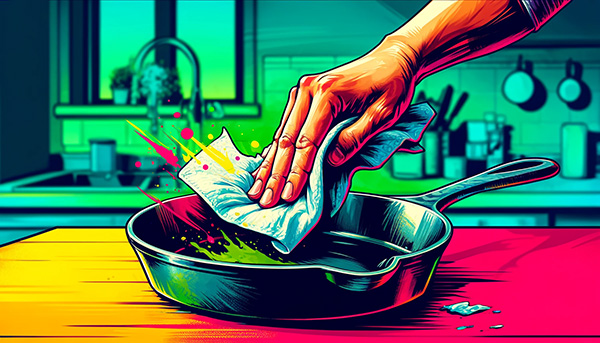
A seasoned cast iron pan refers to one that has been coated with a layer of polymerized oil or fat, resulting in a natural, non-stick surface. Many pre-seasoned cast iron skillets sold are coated with vegetable oil. In this process, multiple layers of oil or fat are applied to the skillet and then heated to a high temperature, enabling the oil to bond with the iron surface. The result is a smooth, dark, and shiny coating that enhances the skillet's non-stick properties and prevents rusting.
So, here's a rundown of how to clean a cast iron skillet of regular food debris, and maybe you'll be able to stop at the first step!
- When your cast iron skillet is perfectly seasoned, a quick wipe with a dry paper towel or cotton dishcloth is all you need to clean it! Food particles will come right off. Cast iron cookware is truly a wonder.
- Water doesn't pose a problem to cast iron if it is dried well later, and we'll get to that. So if dry wiping doesn't get your pan clean, put some warm water in it and use a scrubber to scrape off food residue.
- Add about half a cup of coarse kosher salt to the pan and start scrubbing for an extra boost when cleaning with water. The salt will act as an abrasive.
- After using salt, make sure to rinse off the pan thoroughly.
- Dry and dry completely! This step cannot be emphasized enough. I will emphasize it many times. Dry, dry, dry! Ideally, use heat to do this. You can either place your cast iron skillet back on the stovetop over medium heat until the moisture evaporates or put it into a 350-degree oven for ten minutes.
- Apply a small amount of cooking oil once the cast iron pan is clean and dry. Rub it into the surface of your cast iron skillet, and then place it on the stovetop or back into the oven for ten minutes. This doesn't season your cast iron, but it does help maintain the seasoning process.
Un-Seasoned Cast Iron Cookware
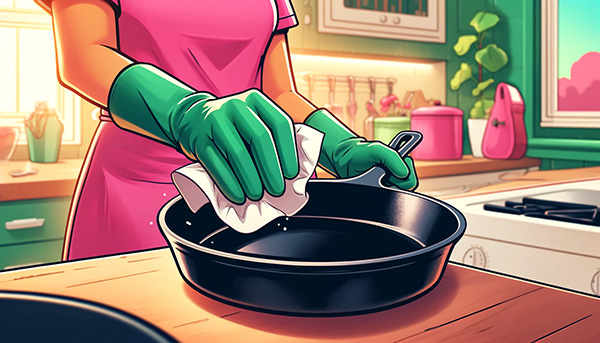
An unseasoned cast iron skillet doesn't contain a protective layer of polymerized oil or fat. It typically has a dull gray appearance and lacks the non-stick properties of a seasoned skillet. Unseasoned cast iron skillets are more susceptible to rust and may require seasoning before use to improve their cooking performance and longevity.
After each use, cleaning an unseasoned cast iron skillet is essential to prevent rust and maintain its usability. Here's a step-by-step guide to cleaning your unseasoned cast iron skillet:
- Allow the skillet to cool slightly after cooking. To prevent cracking, avoid subjecting the cast iron skillet to extreme temperature changes.
- Using a soft sponge or brush, gently scrub away any food residue or stuck-on bits. For stubborn residues, you can add a small amount of mild dish soap to the sponge to aid in the removal process. However, avoid using harsh abrasive cleaners, which may damage the skillet's surface.
- Thoroughly rinse the skillet with warm water to remove all soap and remaining food particles.
- Carefully dry the skillet with a towel or paper towel. Make sure there is no moisture left on the surface, as it can lead to the formation of rust.
- To protect the unseasoned cast iron skillet from rust, lightly coat the interior and exterior surfaces with a thin layer of cooking oil or vegetable shortening. You can apply the oil using a paper towel or cloth, covering the entire skillet evenly.
Tackling Stuck-On Food
The cleaning process above will remove most food residue left in your pan from typical cooking. However, you might find yourself with a patch of truly stuck food, especially with unseasoned cast iron pans.
How To Clean A Cast Iron Skillet Using Salt
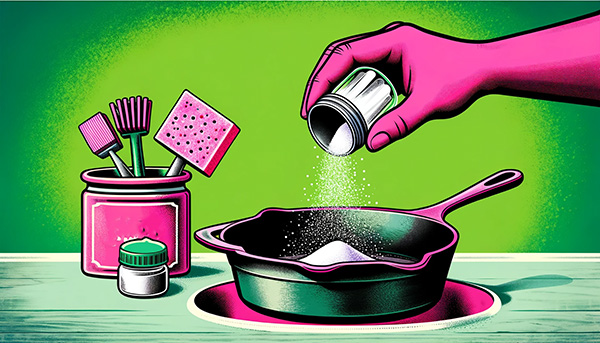
Salt can be used for general cast iron cleaning, but you can also use it for tricky spots.
- Add a half cup of coarse salt and a few drops of warm water to a warm cast iron pan (not hot!).
- Work the salt into the food residue with an abrasive scrubber (such as steel wool or a Scotch-Brite sponge).
- Once you remove the food, give it a good rinse to remove the salt. You might have to do a few rounds of salt scrubbing! Then dry and oil as normal.
How To Clean A Cast Iron Skillet Using Boiling Water

Boiling water is very effective at loosening the burnt food enough that you can scrape it off.
- After cleaning off as much food as possible using the commercial cleaner method above, fill the pan with water and a small amount of dish soap. Be sure that all of the food bits are completely submerged!
- Bring the water to a boil and simmer for ten minutes. Afterward, remove the pan from the heat and let it cool slightly.
- Use a wooden spatula or pan scraper to remove the food. It should have loosened enough to scrape off.
- Stubborn stuck-on food may need another round of boiling.
Handling Rust
A rusty cast iron skillet is undesirable, but unfortunately, it can occur.
How To Clean A Rusty Cast Iron Skillet Using Salt
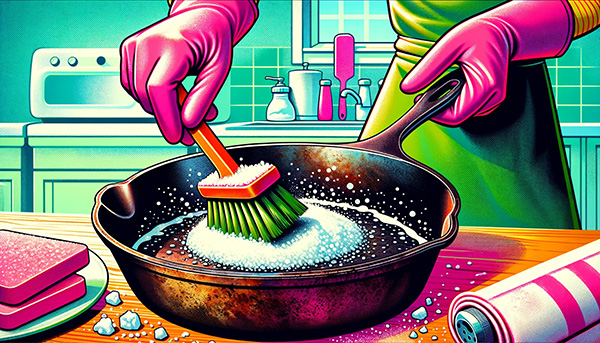
Just as salt can handle the stuck-on bits, it can also handle small areas of surface rust. As mentioned before, add coarse salt and a little water to your cast iron skillet, and use a stiff brush to scrub off the rust.
How To Clean A Rusty Cast Iron Skillet Using A Rust Eraser
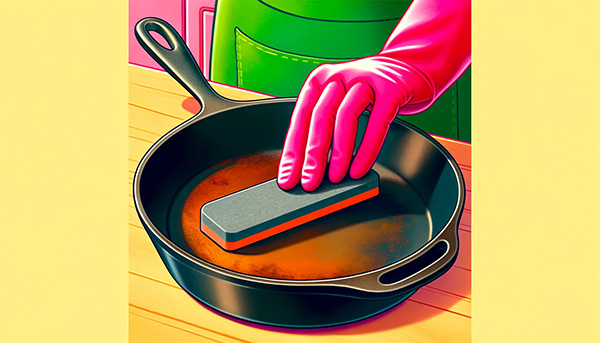
Rust erasers are made from rubber and silicon carbide and work great at removing areas of surface rust. Simply rub the eraser on the rusty spots to remove them - it's as simple as that! But be sure not to press too hard, or it can cause microcracking in the pan, making it more likely to develop rust.
How To Clean A Rusty Cast Iron Skillet Using A Commercial Cleaner
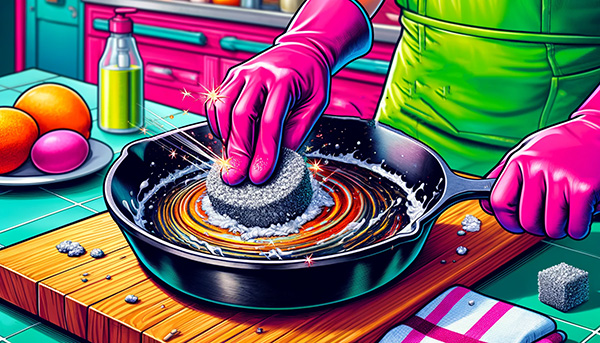
If your cast iron pan is covered with light rust, it's time to break out steel wool (if rust is stubborn), vinegar, or baking soda.
If you have stubborn rust, use fine steel wool or an abrasive pad to lightly scrub the rusty spots. Use gentle pressure to avoid scratching the pan's surface excessively.
For more significant rust issues, create a vinegar soak by filling the pan with equal parts water and white vinegar. Depending on the severity of the rust, let the pan soak for 1-2 hours or longer. The vinegar will help dissolve the rust.
If stubborn rust spots persist, prepare a paste by mixing baking soda and water. Apply the paste to the rusty areas and allow it to sit for a few minutes before scrubbing gently.
General Care Of Cast Iron Skillets
Dry, Dry, Dry! Cast iron is made of iron, and iron and water are not friends! Because of this, many cast iron devotees gasped at the thought of using water to clean their cast iron pots and pans.
However, water doesn't affect the seasoning—it's too gentle for that. The danger is leaving water on the pan; you can fix that by drying it! As mentioned above, you can do this using heat to evaporate the water, but if you'd prefer not to, make sure you dry your cast iron skillet thoroughly.
Scrubbers—Cast iron cookware isn't delicate! If you maintain the seasoning well, you can use harsh scrubbers on it. Feel free to use steel wool, metal mesh scrubbers, and even chain mail! You won't need these intense scrubbers most of the time, but they can effectively handle burnt-on food.
Clean Immediately—Cleaning a cast iron skillet is easiest when it's hot. Move the food you cook in it to a serving dish and wash your pan immediately after using it! Cleaning the hot cast iron pan with food residue using hot water requires much less elbow grease than tackling a cold pan later.
The Dish Soap Debate—While some say that dish soap should be absolutely avoided, as it will eat through the polymerized oil and ruin your pan's seasoning.
The other says that a little mild dish soap to handle particularly tough spots isn't anything to be concerned about. Make your choice and be at peace.
How To Season And Re-season Cast Iron Skillets
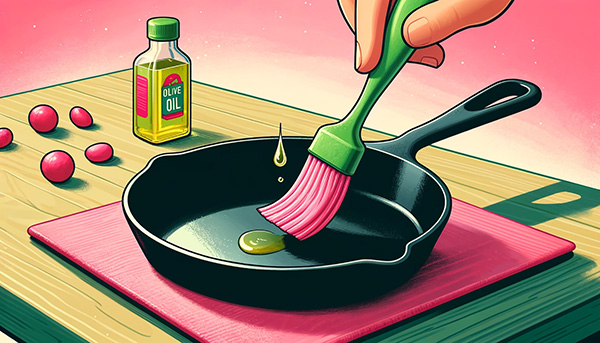
Seasoning and re-seasoning cast iron skillets are essential for maintaining their non-stick surface, preventing rust, and prolonging their lifespan. Below is a step-by-step guide on how to season and re-season your cast iron skillet:
- Wash a new cast iron skillet with warm water and mild soap to eliminate any factory residue or coatings.
- If you are re-seasoning an existing skillet, clean it thoroughly by scrubbing it with hot water and a stiff brush to remove any food residues. Refrain from using soap or harsh detergents, as they can strip away the seasoning.
- After washing, dry the skillet completely using a clean towel. Removing all moisture is essential to prevent rusting.
- Preheat your oven to approximately 375°F (190°C). You can adjust the temperature slightly higher or lower if needed, but it should not exceed the smoke point of the oil you'll be using.
- Select oil with a high smoke point for seasoning your cast iron skillet. Cast iron seasoning oils
- commonly include flaxseed, butter, or grapeseed. Avoid using low-smoke-point oils like olive oil, as they can become sticky during seasoning.Pour a small amount of oil, approximately a teaspoon, onto a paper towel or cloth. Rub the oil all over the skillet's surface, including the cooking surface, outer sides, and handle.
- Once you've applied the oil, use a clean paper towel or cloth to remove any excess. The layer should be very thin and nearly invisible. Avoid applying too much oil, as it can result in sticky or uneven seasoning.
- Place the skillet upside-down in the preheated oven. To catch any excess oil drips, position a baking sheet or aluminum foil on the lower rack.
- Allow the skillet to bake in the oven for approximately 1-2 hours. This process will polymerize the oil, forming a durable, non-stick coating on the cast iron surface.
- Turn off the oven and let the skillet cool inside the oven. If using a new skillet, you can repeat the seasoning process 2-3 times for a stronger seasoning.

